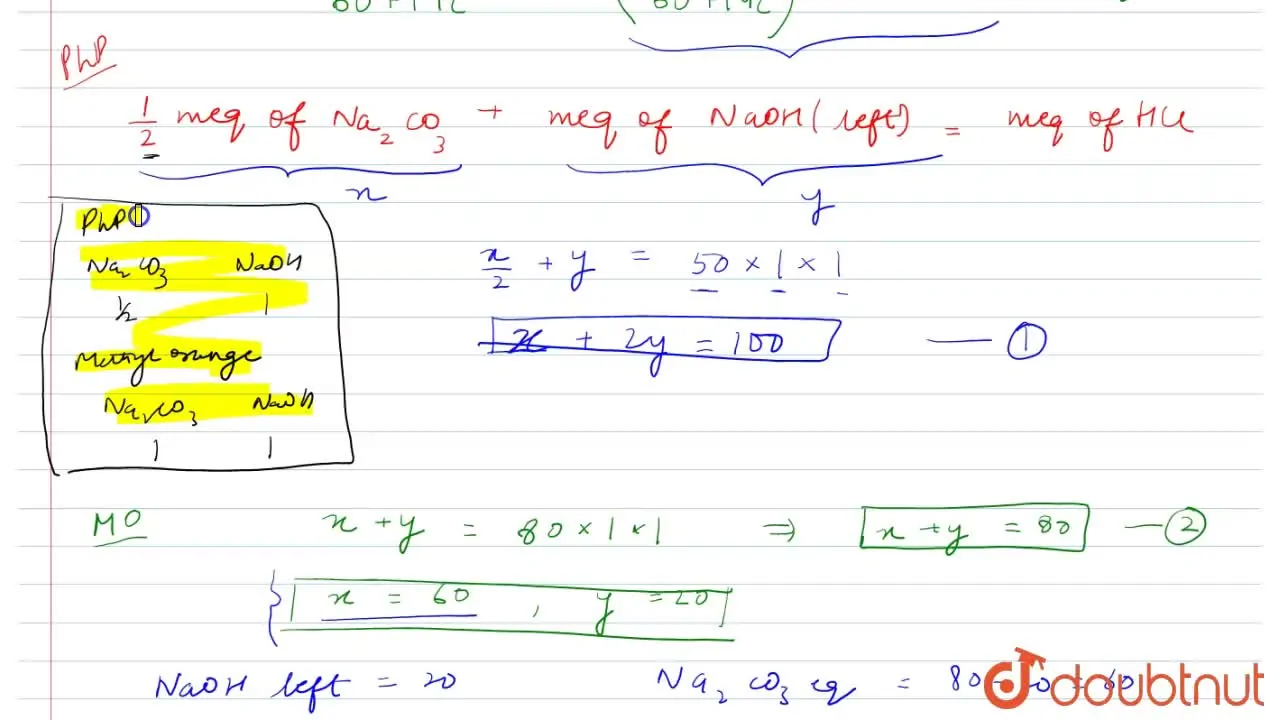0.58 g of was burnt in excess air and the resulting gases and ) were passed through excess NaOH solution. The resulting solution was divided into two equal parts. One part requires 50 " mL of " 1.0 M HCl for complete neutralisation using phenolphthalein indicator. Another part required 80 " mL of " same HCl for neutralisation using methyl orange as indicator. Calculate the value of n and the amount of excess NaOH solution taken initially.
1 " mol of "acid
" mol of "
This is passed in excess where is converted to and some NaoH is left
With phenolphthalein:
left
..(i)
With methyl orange
..(ii)
By equations (i) and (ii) we get
left)
Total m" Eq of "
Weight of NaOH (total)
Also
(n-factor)
Related Playlists
- BOOK - CENGAGE CHEMISTRY ENGLISHCHAPTER - STOICHIOMETRYEXERCISE - Ex 3.610videos
STOICHIOMETRY
- BOOK - CENGAGE CHEMISTRY ENGLISHCHAPTER - STOICHIOMETRYEXERCISE - Ex 3.75videos
STOICHIOMETRY
- BOOK - CENGAGE CHEMISTRY ENGLISHCHAPTER - STOICHIOMETRYEXERCISE - Ex 3.4 (B)18videos
STOICHIOMETRY
- BOOK - CENGAGE CHEMISTRY ENGLISHCHAPTER - STATES OF MATTEREXERCISE - Exercises (Ture False)25videos
STATES OF MATTER
- BOOK - CENGAGE CHEMISTRY ENGLISHCHAPTER - THERMODYNAMICSEXERCISE - Archives (Subjective)23videos
THERMODYNAMICS
Similar Questions
1.7225 g of a metal (bivalent) salt Ax(CO3)y(OH)z was dissolved in water to make 100 " mL of " solution 50 " mL of " this solution required 10 " mL of " 0.5 M H2SO4 solution for complete neutralisation using phenolphthalein indicator. Another 50 mL solution required 15 " mL of " same acid using methyl orange indicator. Deduce the formula of the salt.
View Solution0.126 g of acid required 20 mL of 0.1 N NaOH for complete neutralisation. The equivalent mass of an acid is
View Solution0.1g of a solution containing Na2CO3andNaHCO3 requires 10mL of 0.01 N HCl for neutralization using phenolphthalein as an indicator, mass% of Na2CO3 in solution is:
View SolutionA mixutre solution of KOH and Na2CO3 requires 15 " mL of " N20 HCl when titrated with phenolphthalein as indicator.But the same amoound of the solutions when titrated with methyl orange as indicator requires 25 " mL of " the same acid. Calculate the amount of KOH present in the solution.
View Solution0.075 g of a monobasic acid required 10 mL of N/12NaOH solution for complete neutralisation. Calculate the molecular mass of the acid
View Solution50 ml of water sample requires 10 ml of M50HCl for complete neutralization. Calculate hardness of H2O (temporary) in ppm.
View SolutionA mixture NaOH+Na2CO3 required 25mL of 0.1 M HCl using phenolpththalein as the indicator. However, the same amount of the mixture required 30mL of 0.1M HCl when methyl orange was used as the indicator. The molar ration of NaOHandNa2CO3 in the mixture was:
View SolutionA mixture NaOH+Na2CO3 required 25mL of 0.1 M HCl using phenolpththalein as the indicator. However, the same amount of the mixture required 30mL of 0.1M HCl when methyl orange was used as the indicator. The molar ration of NaOHandNa2CO3 in the mixture was:
View Solution30 " mL of " a solution of mixture of Na2CO3 and NaHCO3 required 12 " mL of " 0.05 M H2SO4 using phenolphthalein as indicator. With methyl orange 30 " mL of " the same solution required 40 " mL of " same H2SO4. Calculate the amount of Na2CO3 and NaHCO3 per litre in the mnixture.
View SolutionHow many " mL of " 0.1 M HCl is required to react completely using phenolphthalein with 2.0 g mixture of Na2CO3 and NaHCO3 containing equimolar amounts of two?
View Solution


